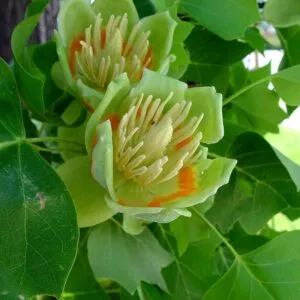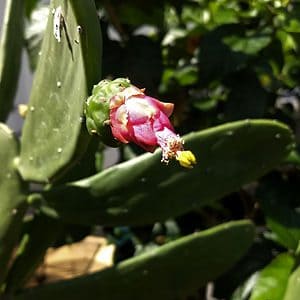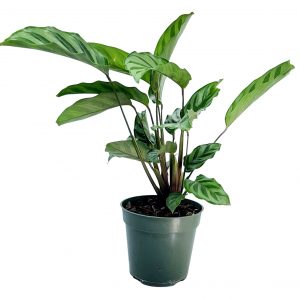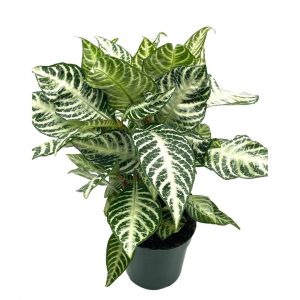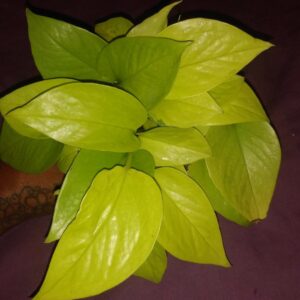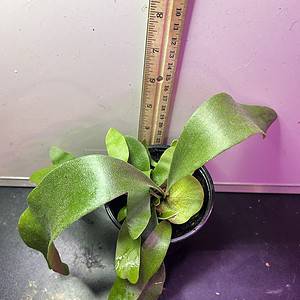No products in the cart.
We can explain why barberry plants are a popular shrub to grow. We can give you five reasons. The barberry is a hardy plant, deer-resistant, and with small thorns, it becomes an outstanding hedge or barrier.
The barberry bush does well in full sun to partial shade, and you get them in cool 😎 colors. Convinced yet! Then let’s look at how you can care for the barberry.
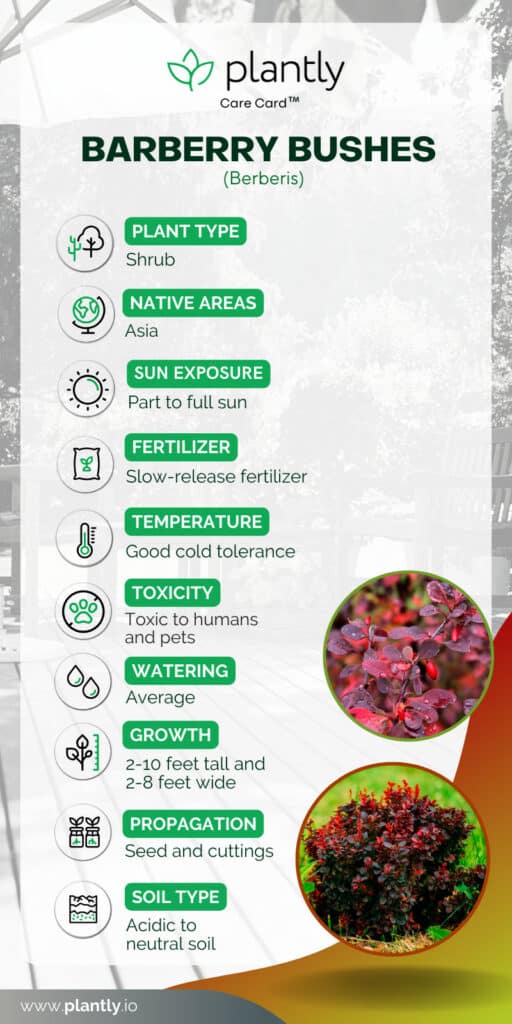
Characteristics of Barberry Plants
You can find many barberry shrubs, as you will learn later. But the majority of the Berberis genus has similar characteristics when it comes to foliage. One thing that all these evergreen shrubs provide is a year-round appeal to the landscape.
The shrubs are not native plants, and they can grow with a rounded form to reach heights of 10 feet tall and 8 feet wide, depending on the species you have. The barberry has a moderate growth rate of one to two feet annually.
The barberry plants spread via creeping roots or seeds as they self-seed with the help of the wildlife that enjoys the barberry fruits. When grown as hedges, the foliage starts green in spring, followed by pale yellow flowers in mid-spring.
As the fall arrives, the leaves turn to fall colors as some are deciduous and lose their leaves. While the berries remain in winter for the birds to forage on, it adds visual interest in the cold months with the sharp thorns.
⚠️Still, a note of warning is that barberry plants have become invasive species in the northeastern United States. So check with your local agricultural extension before planting the barberry bush.
Barberry Shrub Varieties
There are a few barberry shrub varieties you can grow, and as always, remember to check if the one you choose is not an invasive species in your region before planting:
Crimson Pygmy Japanese Barberry
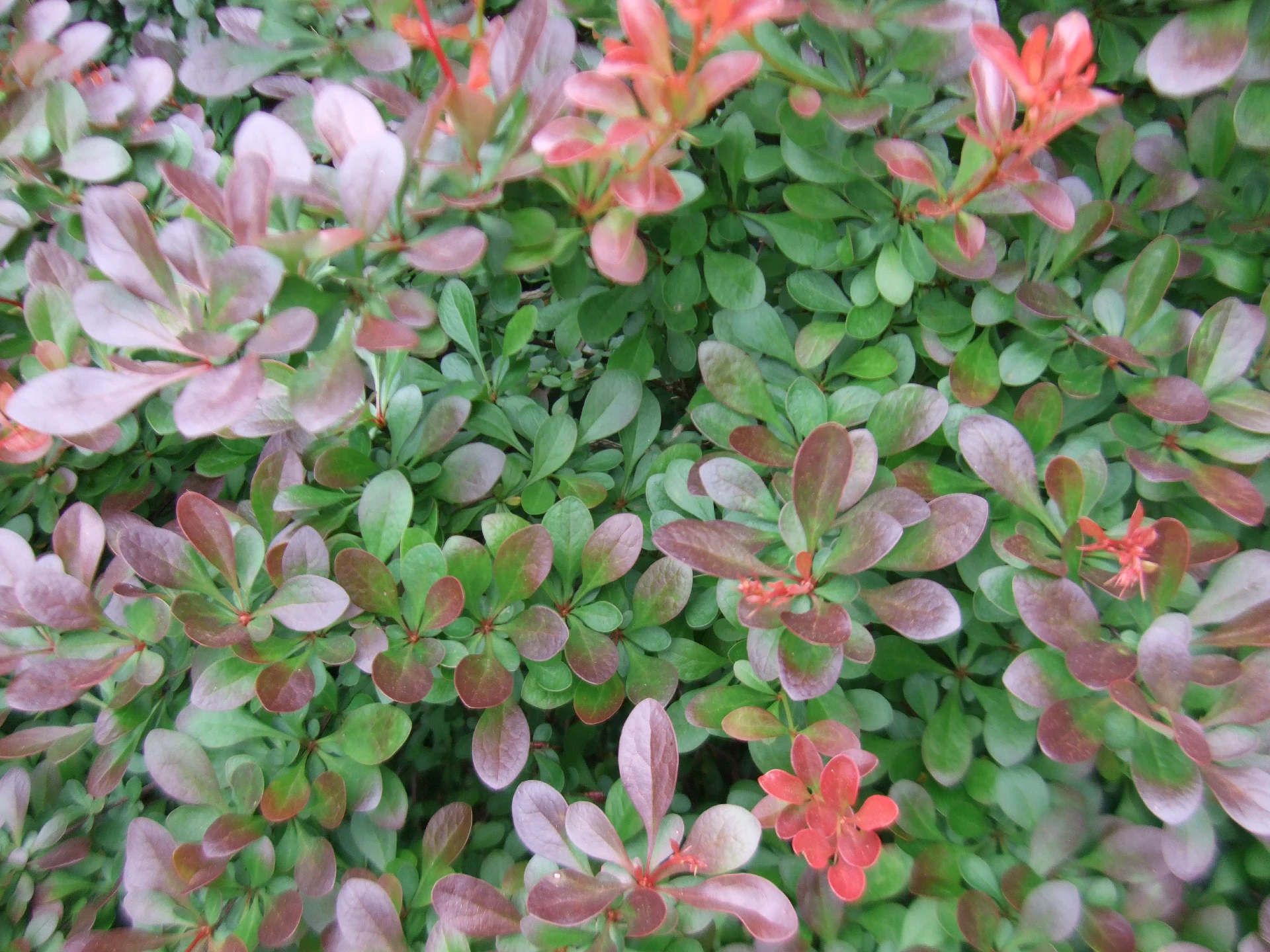
Berberis thunbergii Crimson pigmy is a dwarf barberry with exceptional dark red leaves with a mounded appearance. The shrubs attract birds, and it grows up to three feet tall and wide.
‘Dart’s Red Lady’ Barberry
Another Berberis thunbergii Dart’s Red Lady has dark purple foliage that turns bright red in the fall and reaches up to five feet tall and wide.
Nevin’s Barberry
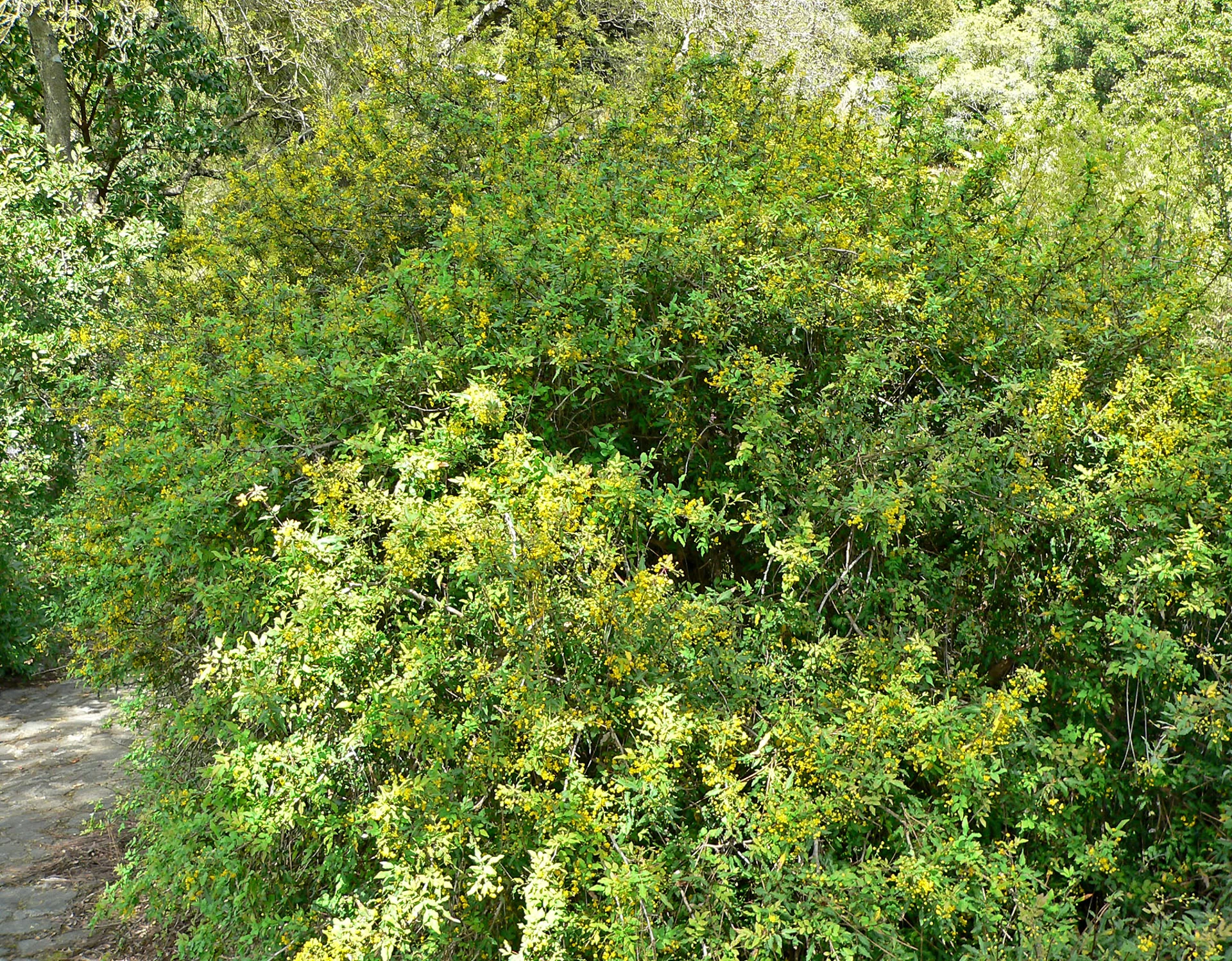
Berberis nevinii are rare plants and needs a lot of tender loving care to grow up to ten feet tall. It blooms bright yellow flowers in winter and spring.
Orange Rocket Barberry
The orange rocket barberry also belongs to the Berberis thunbergii genus and sports unique year-round color. In spring, the vibrant coral foliage ages to ruby red into the fall.
Common Barberry

Berberis vulgaris is the common barberry and the first species not as invasive as the Japanese barberry. It displays serrated leaves with juicy red berries, and the branches also have spines.
Barberry Shrub Plant Care

Barberry plants are thought, and the growing conditions vary for each species. To plant barberry, choose a spot in full sun, which will provide you with the most color in this setting. The barberry bushes can tolerate heavy pollution from salt spray and is a good choice for urban gardens.
How and When to Plant Barberry
Whether you have red barberry, American barberry, Japanese barberry, or any other shrub, the root system needs time before spring to become established. You can plant barberry in a hole twice as wide at the same depth as the nursery container.
Ensure to loosen the soil using a shovel and amend it with compost. Remove your plant, place the root crown at the soil level, and backfill the hole. Water well and apply a two-inch layer of mulch around your plant’s base.
Barberry Light Needs For The Dark Green Leaves

Choose a spot with full sun or partial shade for your Japanese barberries. The warmer the temperature, the more shade your plant needs to prevent the foliage from scorching.
Soil Needs For Barberry Bushes

Whether grown in the ground or in containers, the shrub grows in average soil, but the important thing is to provide well-draining soil. Waterlogged soil will cause root rot.
Watering Barberry Bushes
Depending on your barberry bushes, the Japanese barberry can tolerate drought and only need water in dry periods. When you notice your plant’s leaves wilting and falling off during the growing season, it is a sign of underwatering. Your newly planted barberry bushes need regular watering during the first growing season.
Barberry Temperature and Humidity
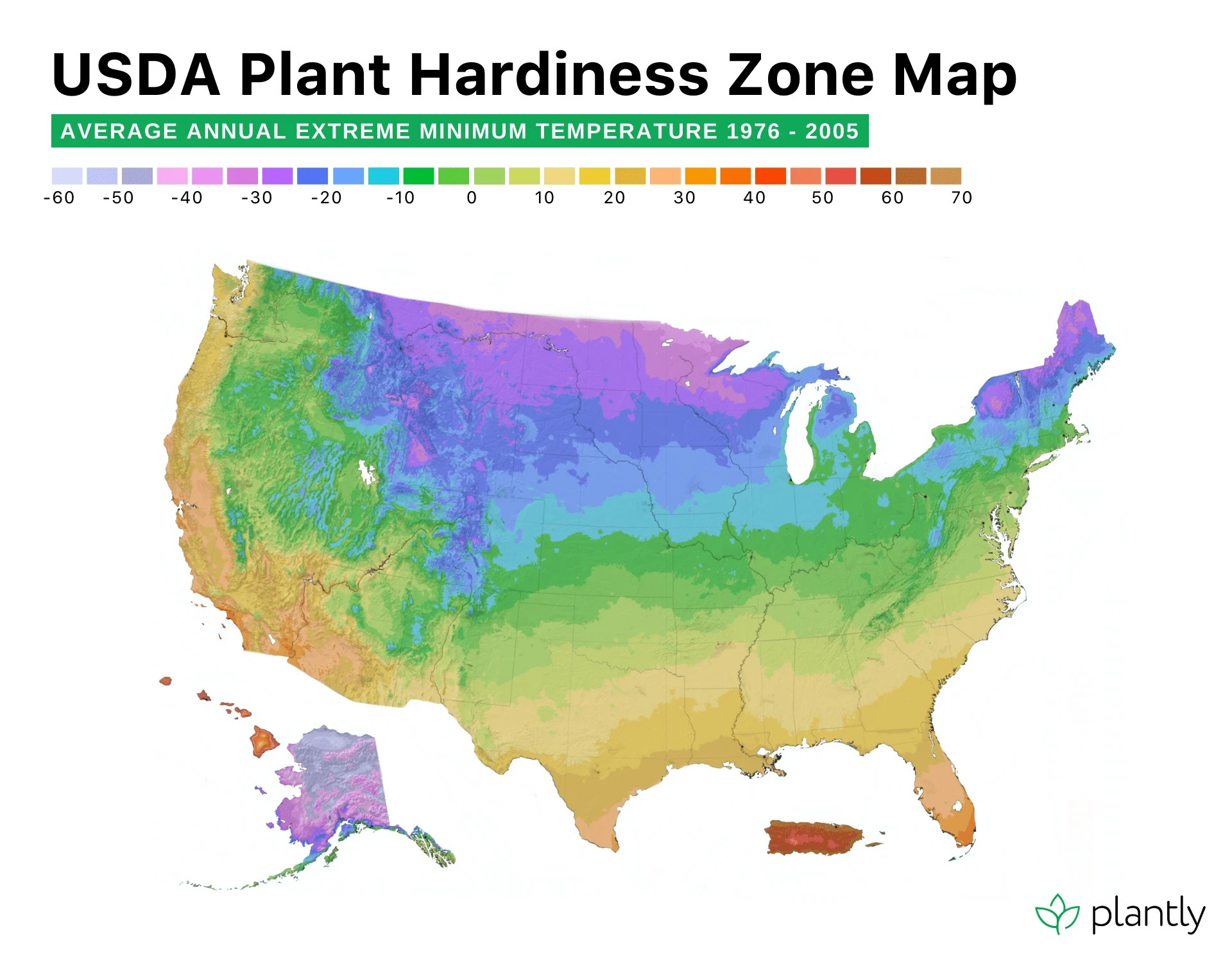
Depending on the site conditions, the shrub can adapt to different climates and does its best in the USDA growing zones 4-8. It can tolerate cold but prefers a sheltered spot protected from strong winds. It can struggle in humid and sweltering temperature 🌡️ conditions.
Fertilizing Barberry Shrubs

You need not fertilize the barberry bush unless the particular area has poor soil conditions. You can boost your plant’s health in the landscape with a slow-release fertilizer for shrubs. You can do this in late winter or early summer.
Overwintering Japanese Barberry Bushes
The barberry bushes do not need special winter care when grown within the hardiness zones. But it is prone to winter wind damage. Hence, it helps to keep your seedlings protected with a burlap wrap used with bamboo stakes.
Pruning Barberry Bushes
The most work to do with the barberry shrub is to keep it trimmed if you are concerned about the size or shape growing as a hedge. You can remove the damaged or diseased branches at any time as they can grow dense.
The best time to prune is after the spring or early summer flowering. We recommend not pruning within two months of the first frost date in the fall, as it leaves the shrub vulnerable to diseases.
⚠️Most importantly, remember to wear gloves to protect your hands from the pointy thorns.
-
Free Shipping$34.95Sold By: CKK PRODUCTS LLC
$39.95In stock
Tulip Tree Seedling XL/jumbo size
Rated 5.00 out of 5 based on 1 customer rating00Sold By: CKK PRODUCTS LLC -
$7.00Sold By: Painted Petals and More
In stock
Nephthytis — Arrow plants
Rated 4.72 out of 5 based on 65 customer ratings00Sold By: Painted Petals and More -
Free Shipping$21.99Sold By: Gar-Zen Botanical Design
In stock (can be backordered)
Opuntia Pear Spineless Cactus (2 Pads) Ships Free.
Rated 4.86 out of 5 based on 49 customer ratings00Sold By: Gar-Zen Botanical Design -
Free Shipping$22.99Sold By: Gar-Zen Botanical Design
In stock (can be backordered)
Plumbago auriculata Cape leadwort, Blue Plumbago Ships Free.
Only 10 available and it’s in 1 people’s basketRated 4.86 out of 5 based on 49 customer ratings00Sold By: Gar-Zen Botanical Design
Propagating Japanese Barberry Shrubs
The best way to propagate your shrub is through cuttings or seeds. For cuttings, please take it in spring after it flowers and fades. Or you can take a semi-hardwood cutting in summer.
Stems Cutting Propagation
Take a six-inch growth from the branch tip, cutting below a leaf node on the parent plant.
Remove leaves and shoots at the bottom and leave greenery at the top.
Dip the cut end into a rooting hormone, place it in a pot filled with coarse sand drenched with water, and leave it to drain.
Leave the leaves above the sand and mist the cutting with water to cover with a plastic bag to retain moisture.
Monitor your seedlings and moisten them when the soil dries.
Your cutting should be rooted in about 21 days; once established, you can transfer it to a larger pot and continue caring for it to transplant to the garden in the fall.
How to Grow Barberry From Seed
As the barberry shrub self-seeds freely, you can quickly propagate it from the seed. You can plant the tiny seed found in the bright red berries.
Collect the fruits in late summer or early fall and mash them.
Plant the seeds in pots filled with peat moss or coir with sand and moisten.
Cover the pots with plastic wrap, poke some holes, and leave them in a refrigerator for two months to stratify. Keep the potting medium moist but not soggy.
Then remove it from the cold and leave it standing in a cool place and water to watch the germination occur after it warms up.
Continue growing your plants in the cold frame until they reach three inches high.
Then transplant them into larger pots and keep them in a protected spot with dappled shade until the frost passes.
Then plant them in your garden in early fall.
Barberry Common Pests & Plant Diseases
These species are susceptible to aphids and scale insects that suck out the plant’s nutrients. You can dislodge large infestations with a high-pressure spray of water 💦.
Another concern is Lyme disease ticks, as it has dense foliage, and they use it as a home to survive. But these ticks die if the humidity levels are kept below 80% without rising again.
Some diseases are powdery mildew, anthracnose, and verticillium wilt with bacterial leaf spots. You can use a fungicide for most of these problems.
Frequently Asked Questions
While the yellow blooms are not showy, they can still produce red fruits that give a winter appeal. If your shrub fails to bloom, it is not getting enough direct sunlight or is overfertilized. Even severe pruning can halt the flowering and is best done after the flowers fade.
The evergreen shrubs’ roots cannot tolerate fluctuations in moisture. So, if it is constantly dry or overly wet, it can result in sudden death for mature plants during summer. It helps to add a layer of mulch around the root system to prevent this from happening.
When grown as a hedge in the landscape, you may find burned spots on the lower branches resulting from a dog’s urine.
You will need to dig up as much of the root system as possible and keep an eye 👁🗨 on new shoots emerging. In contrast, you will need to kill the new plants using a herbicide which can take a few months to be removed.
You can grow these shrubs in the garden as hedges or for barrier planting. The sharp thorns create a fence to keep out deer and help control erosion.
The plant has underground roots, and a single shrub can expand to thrive for decades. The individual stems become woody and eventually cease to produce blooms and fruits.
The fruits attract birds in winter, while the thorns prevent deer and other animals from grazing on the plant.
The barberry shrubs can be evergreen or deciduous. The deciduous barberry shrub loses its leaves in winter, while the evergreen shrubs remain green in summer, changing to fall and winter colors from deep burgundy, orange, or red.
Whether you want to buy, sell, or simply reach out to other plant enthusiasts, Plantly is the right place to be!
-
$18.00 – $23.00Sold By: PotHedz Plants
Calathea Freddie
Rated 4.96 out of 5 based on 106 customer ratings00Sold By: PotHedz Plants -
$15.99Sold By: BubbleBlooms
In stock
zebra plant in a pot
Rated 4.81 out of 5 based on 279 customer ratings00Sold By: BubbleBlooms -
$20.00Sold By: Soul Peace Gardens
In stock
Soul Peace Bundle-Neon
Only 1 available and it’s in 1 people’s basketSold By: Soul Peace Gardens -
$20.00Sold By: Painted Petals and More
In stock (can be backordered)
Staghorn Fern
Rated 4.72 out of 5 based on 65 customer ratings00Sold By: Painted Petals and More
